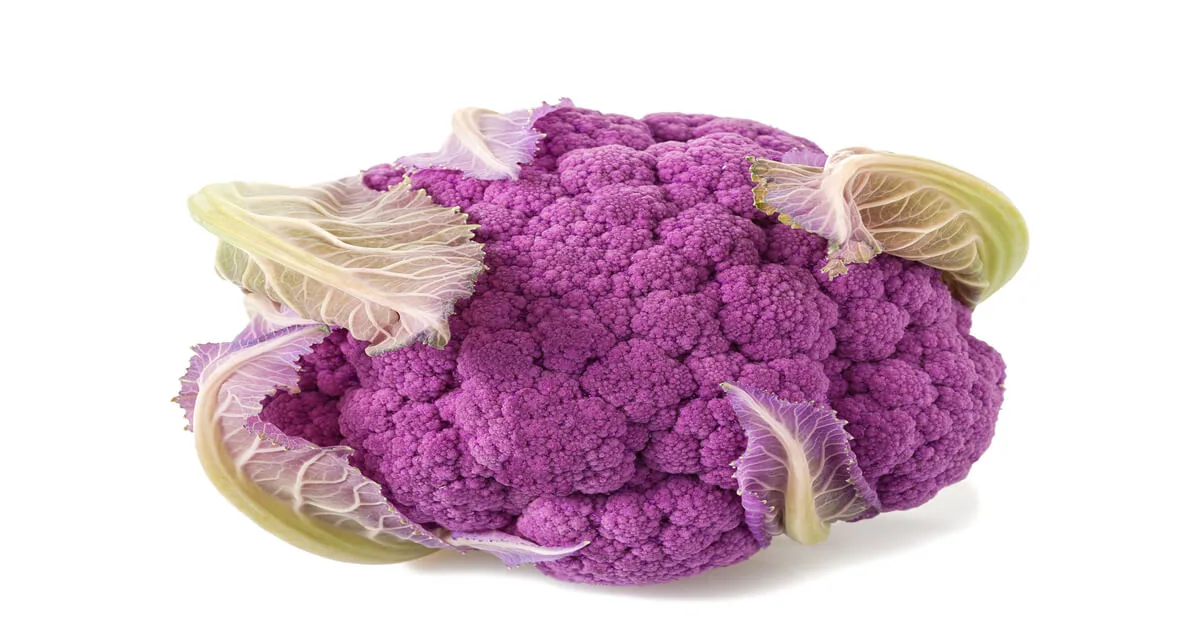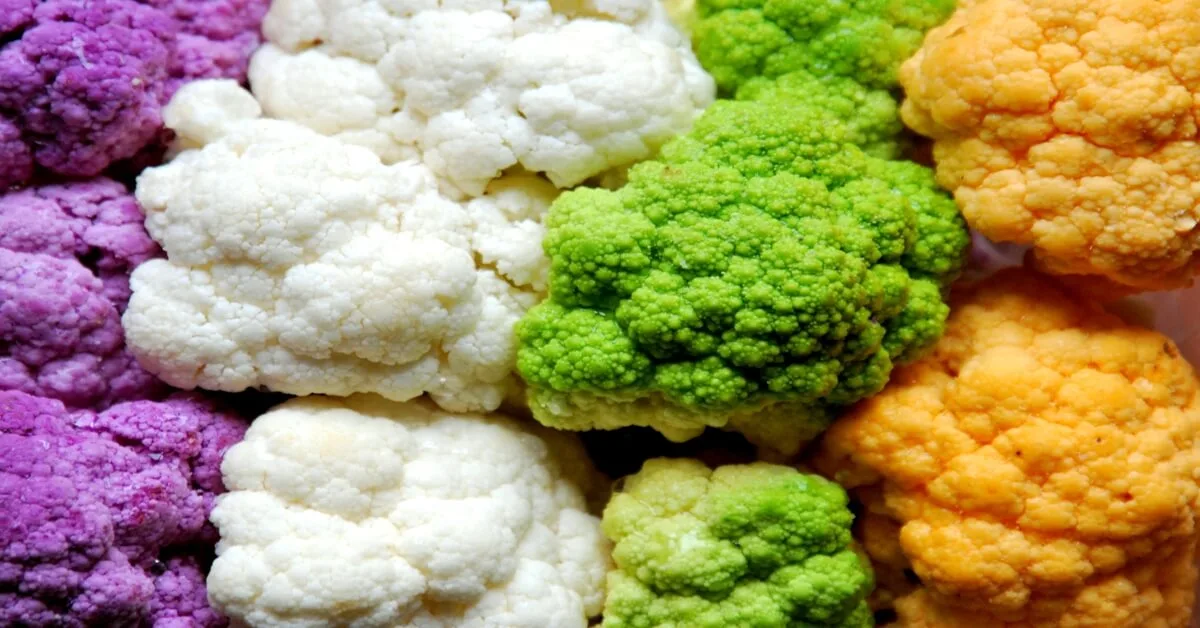Cauliflower (Brassica oleracea var. botrytis) is an annual vegetable and member of the mustard family (Brassicaceae). It is a specific variety of wild cabbage that has a genetic mutation. This mutation causes the inflorescence meristem to form dense, white, edible clusters.
Mutations found in wild cabbage plants have led to the development of other cultivars. These include cabbage, broccoli, Brussels sprouts, kale, and collard greens. All of these vegetables are cultivars of the Brassica oleracea plant.
Cauliflower is one of two vegetables that are composed of flower buds. The other is broccoli. The edible part is referred to as the head or curd. In this article, we’ll tell you everything you need to know about cauliflower and how to grow it.
History Of Cauliflower
The precise origin of cauliflower is unknown. In the 12th century, an Arab botanist wrote that it originated in the Cyprus region of the Mediterranean[1]. It did not gain popularity across Europe until the 17th century. At this time it began to become common in countries such as England and France.
In the early 1800s, Europeans introduced cauliflower to other regions like India[1]. It would be 100 years before cauliflower made it to consumers in North America.
Cauliflower Plant Care

Cauliflower is a cool-season plant that can be grown in early spring or late fall. It performs best when it has consistent soil moisture, soil nutrients, and temperatures.
Cauliflower is relatively easy to grow once they reach the vegetative stages. Starting plants from seeds can be difficult, as seedlings can be a bit fussy. Providing enough fertilizer and water throughout the growing season is critical.
Soil
Cauliflower needs well-draining soil with a pH between 6.5 and 6.8. If you have sandy or clayey soils, make sure to till in plenty of organic matter.
A lack of boron can cause the curds to become brown. This can be reversed by mixing 1 tablespoon of borax with a gallon of water. Pour this mixture over the soil every two weeks until the color reverts back to white. You can prevent this issue by tilling compost into the soil before planting.
Watering
Cauliflower needs 2 inches of water per week and often requires supplemental watering. It produces best when soil moisture is kept consistent throughout the growing season. It’s best to provide 1 inch of water every 3 to 4 days.
Buttoning may occur if soil moisture isn’t kept consistent enough. Buttoning refers to the plant forming many small florets rather than a single large head.
When cauliflower doesn’t get enough water it can become bitter. Once the heads begin to form, make sure to keep the soil from drying out completely. This could cause the curds to begin opening, impacting the texture of harvested crop. A layer of mulch over the soil will help with moisture retention.
Lighting
Sunlight is critical for all plant growth. So does cauliflower need full sun or does it do better with some shade? The answer is both.
Cauliflower needs full sun which means 6 to 8 hours of sunlight per day. However, too much sun can cause the curds to turn pinkish. The intense afternoon sun can also lead to scorching. Plant cauliflower where it will get at least 6 hours of sunlight early in the day and shade in the afternoon.
Humidity & Temperature
Ideal temperatures for growing cauliflower are between 50 to 70 degrees Fahrenheit. Humidity typically doesn’t significantly impact cauliflower growth.
When temperatures aren’t consistent, cauliflower curds may begin turning a pinkish color. When temperatures remain above 86 degrees Fahrenheit, cauliflower may not produce heads.
Fertilizing
It is best to test your soil for its nutrient content before planting any crop. However, if you don’t test, add 1.5 to 2 lbs of 5-10-10 fertilizer for every 50 square feet of soil before planting. Till the soil to incorporate the fertilizer well.
Add fertilizer to cauliflower when plants reach a height of 4 inches. Fertilizing crops after they emerge is known as side dressing. Use a high-nitrogen fertilizer such as 12-24-12.
Without enough nitrogen, leaves will begin to yellow at the bottom of the plant. Low nutrients can cause curds to take on a purplish hue.
Diseases & Pests
There are several pests and diseases that negatively impact cauliflower growth. However, many varieties are available which are resistant to certain insects and diseases.
The table below lists the most common diseases and pests of cauliflower. It also describes the damage they cause.
| Pest Name | Signs & Symptoms |
| Alternaria | A fungus that causes leaves to develop spots and crowns to rot. |
| Aphid | A sap-feeding insect that causes leaves to become distorted, stunted, and/or yellow. They produce sticky honeydew which can cause sooty mold to grow. |
| Black rot | A fungus that causes triangular, yellow spots along the leaf margins. Can also cause crown rot. |
| Cabbage looper | A caterpillar that feeds on the leaves, creating large holes. |
| Cabbage maggot | A fly larvae that feed on roots and can cause plants to be stunted from lack of nutrients. Severe infestations can lead to plant death. |
| Clubroot | A fungus that impacts the roots causing them to enlarge leading to stunted plants. |
| Diamondback moth | A caterpillar that feeds on the leaves, leaving large holes. They can also feed on broccoli heads. |
| Downy mildew | A fungus that causes a white to gray cottony growth on the underside of leaves. Jagged, yellow spots develop on the leaf’s surface. Leaves eventually become distorted and drop from plants. |
| Flea beetle | A beetle that feeds on leaves leaving small holes. |
| Imported cabbage worm | A caterpillar that feeds on the leaves, leaving large holes between the midrib and larger leaf veins. |
Days To Maturity
The amount of time it takes cauliflower to mature is anywhere from 40 to 100 days. The biggest factor impacting cauliflower maturation is the cultivar you plant. Low or high temperatures, lack of water, and lack of nutrients can also slow its growth.
Harvesting
Cauliflower should be harvested 7 to 12 days after blanching or when heads are 6 to 8 inches across. If the head begins to open, harvest immediately as it won’t get any larger and will soon spoil.
Use a sharp, clean knife or shears to remove the heads. Make the cut a few leaves below the head as the leaves will provide protection during storage.
Place harvested heads in a plastic bag in the fridge for up to a week. To store them longer, cut up the curds and blanch them in water for about 3 minutes. Allow them to cool completely before storing them in a sealed container in the freezer.
How To Plant Cauliflower

Knowing when to plant cauliflower depends on where you live. Check to see when the average last frost date is for your area when planting in spring. Find out the average first frost date when planting in the fall. Use these dates to determine when to plant based on which planting method you choose to use below.
You can either use direct sowing or transplanting. Direct sow seeds no more than 1 week before that last frost date in your area in spring. In fall, plant them when daily temperatures regularly stay below 75 degrees Fahrenheit.
Sow seeds ½ inch deep. The ideal cauliflower plant spacing is 18 to 24 inches apart. Rows should be at least 24 inches apart.
Start seeds indoors 2 to 4 weeks before the last frost date for spring planting. Start them in late July for fall plantings. They should have at least 4 to 5 true leaves before being transplanted.
Transplants need to be hardened off before being planted outside. To do this, place them outside for a few hours a day to get some sunlight. Don’t leave them out in the harsh afternoon sun. Do this for 3 days before you plan to transplant them.
Succession planting cauliflower will allow you to harvest curds for longer. To achieve this, plant a few plants every one to two weeks so they don’t all mature at the same time.
When the heads are about 2 to 3 inches across, you’ll need to blanch them. You’ll want to pull the leaves up over the head and secure them with something like string. This prevents sunlight from getting to the head.
Some varieties are self-blanching, so you won’t need to do this. Colored varieties also don’t require blanching.
Cauliflower Growing Stages
The germination stage is the first growth stage. It begins when the plant emerges from the soil until it produces its first set of true leaves. This stage typically lasts 8 to 10 days.
Next is the seedling stage. During this stage, cauliflower plant leaves will continue to form and grow. The cauliflower seedling stage lasts for four to six weeks.
The vegetative stage comes next. This is when plants will put on the majority of their leaves and develop a much larger root system. The rapid increase in leaf area and roots prepares cauliflower to produce its heads.
The final stage is the maturation stage. This stage begins when you see the heads beginning to form. Most varieties will produce a tightly packed head that is 6 to 8 inches across. Once the head reaches its mature size, it’s time to harvest.
Types Of Cauliflower

Hundreds of varieties of cauliflower are available. They are divided into four main groups depending on where they originated. Cauliflower groups are Italian, Northern European annuals, Northern European biennials, and Asian.
Cauliflower also comes in a variety of colors with white being the most common. Purple cauliflower gets its color because it produces anthocyanins. Similarly, orange cauliflower varieties produce beta-carotenes. Green cauliflower has been crossed with broccoli causing its heads to be green.
Here are a few of the most popular cauliflower varieties to grow.
| Name | Characteristics | Days to Harvest |
| Cheddar | Produces orange heads. Heat tolerant. | 58 |
| Graffiti | Produces purple heads. Best when used for fall plantings. | 75-80 |
| Montana | Produces white heads. Tolerates heat and humidity well. Resistant to some foliage diseases. | 45-55 |
| Romanesco | Produces light green heads. Curds have a somewhat pyramid shape. | 70-100 |
| Rushmore | Produces white heads. Resistant to turning pinkish. | 74 |
| Summex | Produces white heads. Resistant to higher temperatures and diseases. | 40 |
| Titan | Produces white heads. Resistant to higher temperatures. | 75 |
Cauliflower Companion Plants
Cauliflower performs well when planted alongside beets, Chinese cabbage, green onion, lettuce, marigolds, mustard, potatoes, spinach, and sunflowers.
You shouldn’t plant cabbage, peppers, pole beans, strawberries, or tomatoes near cauliflower.
Cauliflower vs Broccoli
The main difference between cauliflower and broccoli is the texture of their heads. Cauliflower is dense while broccoli is more fluffy. Cauliflower also comes in a variety of colors while broccoli is only green. Cauliflower has a milder taste while broccoli is slightly bitter.
The nutrients in cauliflower also differ from broccoli. It has less fiber, carbs, calories, fat, and protein[1]. It has more vitamin B6, folate, and pantothenic acid than broccoli.
References
[1] Cauliflower. (2023, January 7). In Wikipedia. https://en.wikipedia.org/wiki/Cauliflower

